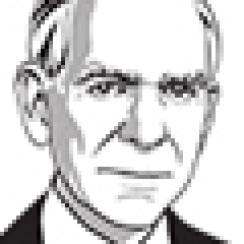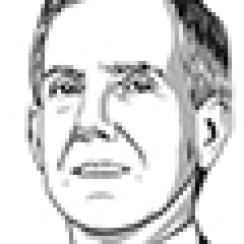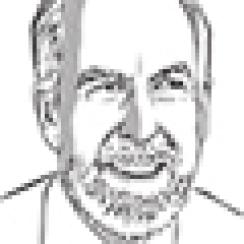Value investor Bruce Berkowitz, founder of Miami-based Fairholme Capital Management, admits he has only a few good ideas — ten or 12, to be exact. Although many managers own the stocks of hundreds of companies, Berkowitz says investing in his 20th-best idea doesn’t make sense when he could put more money into his first. With 80 percent of his flagship Fairholme Fund’s returns coming from the low price he pays for stocks, Berkowitz looks for a handful of businesses that are resilient, essential to the economy and despised by investors. He identifies important ideas and companies that can exploit them, builds in a huge margin of safety by buying when the crowd is running in the other direction and invests only in securities whose ultimate turnaround depends on a very small number of variables. It’s this combination of behavioral finance knowledge and an in-depth understanding of companies that allows Berkowitz to laser-focus on just a few investments and avoid worrying about overall economic growth to generate returns.
“In the past few years, you had to be as much a psychologist as an accountant,” says Berkowitz, 55, who emphasizes that paying a cheap price — a lot less than he believes a company is worth — provides him with a margin for error. “That gives us the time needed for perceptions in the market to change,” he explains. Berkowitz hardly shrinks from controversy: Two of his biggest holdings and top performers in the past year were mortgage giants Fannie Mae and Freddie Mac, whose future is being debated in Congress.
Berkowitz is Money Manager of the Year in Institutional Investor’s fifth annual U.S. Investment Management Awards. The founder of $11 billion-in-assets Fairholme Capital joins Jeremy Grantham, the “G” in Boston-based GMO and Manager Lifetime Achievement Award winner; Investor Lifetime Achievement winner D. Ellen Shuman; and our Outstanding Contribution winner, the late Anne Pfeiffer of J.P. Morgan Asset Management.
| Top 10 Institutional Investors of 2014 |




|




|


|
We also honor the best investment professionals among small and large public and corporate pension plans, endowments and foundations. Our team researched investors based on performance, innovation and leadership in the institutional investor community.
The 2014 U.S. Investment
Management Award WinnersHere are the money managers recognized by endowments,
foundations, pension funds and other institutional investors for innovation and impressive returns during 2013.
| Category | Winner |
| Cash Management | Federated Investors |
| Commodities & Energy | Gresham Investment Management |
| Core Fixed Income | Western Asset Management Co. |
| Core Plus Fixed Income | Western Asset Management Co. |
| Corporate Fixed Income | Loomis, Sayles & Co. |
| Emerging-Markets Debt | Goldman Sachs Asset Management |
| Emerging-Markets Equity | Thornburg Investment Management |
| Exchange-Traded Funds | BlackRock |
| Fixed -Income Indexer | Northern Trust Corp. |
| Funds of Hedge Funds | Blackstone Group |
| Global Equity | AQR Capital Management |
| Global Fixed Income | Pacific Investment Management Co. |
| Government Fixed Income | Putnam Investments |
| Hedge Funds | Bridgewater Associates |
| High-Yield Fixed Income | MacKay Shields |
| Infrastructure | Global Infrastructure Partners |
| Investment-Grade Fixed Income | Garcia Hamilton & Associates |
| Large-Cap Core Equity | J.P. Morgan Asset Management |
| Large-Cap Growth Equity | T. Rowe Price Group |
| Large-Cap Value Equity | T. Rowe Price Group |
| Liability-Driven Investments | Legal & General Investment Management America |
| Midcap Core Equity | ClearBridge Investments |
| Midcap Growth Equity | Artisan Partners |
| Midcap Value Equity | MFS Investment Management |
| Mortgage-Backed Securities | DoubleLine Capital |
| Municipal Fixed Income | Northern Trust Corp. |
| Mutual Fund Manager | Vanguard Group |
| Non-U.S. Equity Growth (excluding emerging markets) | Morgan Stanley InvestmentManagement |
| Non-U.S. Equity Value (excluding emerging markets) | Acadian Asset Management |
| Non-U.S. Fixed Income (including emerging markets) | Franklin Resources |
| Private Equity | Blackstone Group |
| Real Estate Investment Trusts | Cohen & Steers |
| Small-Cap Core Equity | PanAgora Asset Management |
| Small-Cap Growth Equity | TimesSquare Capital Management |
| Small-Cap Value Equity | Invesco |
| Venture Capital | Sequoia Capital |
| Money Manager of the Year | Bruce Berkowitz, Fairholme Capital Management |
Money managers don’t have it easy. Economic growth has remained lukewarm since the financial crisis, with U.S. gross domestic product expanding just 2.6 percent in 2013. The U.S. growth rate is expected to be similar this year; unemployment is still at a stubbornly high 6.7 percent. Other economies are similarly cool. The European Union is forecast to expand by 1.5 percent this year and 2 percent in 2015. China is particularly problematic: For the past two years, the world’s second-largest economy has been growing at its slowest pace since the late ’90s Asian crisis (see also “For Southeast Asia, the Recent Turmoil Is Anything but 1997 Again”).
“We believe that even in low-GDP-growth environments there will be unique companies to invest in, with sustainable competitive advantages and opportunities for growth from pricing power, new products and new markets,” says Kristian Heugh, who heads the global opportunity strategy at Morgan Stanley Investment Management, which has $373 billion in assets and wins Non-U.S. Equity Growth Manager of the Year. “Entropy is inevitable. Therefore a key part of our process is identifying companies that are likely to benefit from disruptive change and avoiding those companies likely to suffer from disruption.”
Last year was a watershed year for fixed-income managers, who struggled to cope with rising rates after the Federal Reserve announced in the spring that it would scale back the pace of its bond purchases. Investors quickly turned to unconstrained funds, which give managers the ability to go anywhere in the market to enhance yields and hedge against interest rate hikes (see “A Brave New World for Bond Investors”). Pasadena, California–based Western Asset Management Co., Manager of the Year in both the Core and Core Plus Fixed Income categories, has been running unconstrained funds for a decade. Core bonds, which are benchmarked to the Barclays Aggregate Bond Index, have long been the largest part of the fixed-income business, but today assets are moving into not only unconstrained funds but also emerging-markets bonds, bank loans and high-yield debt. “The trend is to disaggregate the Agg,” says Carl Eichstaedt, who manages core bonds for Western. He emphasizes, though, that core mandates are not going away any time soon: “They still pay the bills.”
Bond managers have tools to help investors in rocky times. Colin Robertson, head of fixed income for Chicago’s Northern Trust Corp., says his success last year resulted in large part from his firm’s not being forced to sell in stressful markets. The Municipal Fixed-Income Manager of the Year continued to buy securities in what was a record year of outflows for muni bond mutual funds. Other winning fixed-income managers include Boston-based Loomis, Sayles & Co., Corporate Fixed-Income Manager of the Year, and New York’s MacKay Shields, High-Yield Fixed-Income Manager of the Year.
Value investors don’t need fast economic times, but they do want stability. Fairholme’s Berkowitz prospered last year thanks to investments he made in 2011, including his two biggest positions, American International Group and Bank of America Corp., which he purchased well after the crisis had brought both companies to their knees.
“People who normally invest in these companies were so badly burned in 2008, ’09 and ’10 that they couldn’t see their way back to them again,” says Berkowitz, whose fund was up 35.5 percent in 2013. “A cat burned by a hot stove won’t sit on a hot stove again. But it also won’t sit on a cold stove.”
Although the best managers use a detailed map when investing, their solid sense of direction gives them the confidence to follow new routes when necessary. R. Canon Coleman II, lead manager of the Small Cap Value Fund for Invesco, which has $787 billion in total assets, says his team doesn’t set targets for how much it wants to own in sectors such as technology or heath care. Instead, it looks for the best opportunities anywhere in the market based on valuation.
Invesco, Small-Cap Value Equity Manager of the Year, has been able to succeed since the financial crisis — and in particular in 2013 — with a bottom-up, long-term investment strategy that seeks to buy when other investors are fearful and stocks are trading at a discount. Coleman, whose firm runs $3.5 billion in small-cap value assets, says the markets have been climbing since the crisis, but they’ve also been volatile, with emotions frequently running high. “Everybody is so excited, and then everybody is so bearish,” he explains.
To make good decisions amid rocky markets, the Invesco team chooses investments that will likely play out over several years. The fund bought Milwaukee-based ManpowerGroup in 2011 and 2012. At the time, the stock of the temporary-staffing company was getting knocked around because of its large exposure to Europe, which was in the thick of its debt crisis: Europe generates more than 60 percent of Manpower’s revenue. Last year the company’s stock price more than doubled from 2012.
“What’s doing well at any one point is what we purchased probably years before, so we can block out the noise,” Coleman adds. Today there aren’t as many opportunities because the markets are much more fairly valued, he says, but “there are always companies having short-term issues, even if the discounts aren’t as large at any given point in time.”
Kevin Schmitz and Brooks Taylor, who have been co–portfolio managers of MFS Investment Management’s institutional midcap value strategy since November 2008, attribute their fund’s consistent performance to their diverse sources of ideas. The midcap value fund’s holdings today represent picks from 30 different analysts at the global firm. In 2013, MFS’s Canadian research group led the co-managers to invest in Shoppers Drug Mart Corp. — a unique holding for a U.S. midcap value fund. In March, Loblaw Cos., Canada’s largest retailer, completed a C$12.4 billion ($11.25 billion) cash-and-stock acquisition of the Toronto-based pharmacy chain. Boston-based MFS, which has $421 billion in assets under management, is Midcap Value Equity Manager of the Year.
Schmitz and Taylor, longtime friends who played tennis together for years before becoming co-managers, say the partnership skills required to win in doubles are the same as those needed to comanage a fund. The MFS midcap value fund managers are stock pickers through and through. They don’t try to figure out the direction of the market. “We don’t make huge stock or sector bets, and you’ll never hear us talking about whether we’re bullish or bearish,” Schmitz says. “We’ll underperform at some point, but it won’t be because of the market,” adds Taylor. “It will be because of a stock pick.”
Thomas Luddy, portfolio manager in the U.S. equity group at J.P. Morgan Asset Management, Large-Cap Core Equity Manager of the Year, says two beliefs have driven his strategy since he became a stock picker in 1982. First, a company’s cash flows determine value; second, behavioral finance theories are valid and play out in the market every day. Luddy, who was II’s Money Manager of the Year in 2010, is a fundamental investor who makes decisions based on the specific characteristics of companies. But his strategy at J.P. Morgan, which has $1.5 trillion in assets under management, is also informed by overall trends in the market.
Luddy says behavioral finance and cash flow analysis have been colliding since the financial crisis. On the behavioral front investors are still skittish about equities even though the market bottomed out five years ago. That has created a quirky relationship between stocks and bonds. Investors are now overpaying for a bond’s coupon — because they love the perceived safety of fixed income — at the expense of a cash flow stream they could get by owning the company’s stock. Luddy, for example, has been able to buy stocks like Johnson & Johnson, which has a dividend yield of about 3 percent, similar to the yield on J&J’s ten-year corporate bonds but with the potential for stock price appreciation.
Making money in a slow-growth economy is challenging. Artisan Partners, Midcap Growth Equity Manager of the Year, has long believed that the tepid macroeconomic environment since the crisis would make it difficult for the average company to grow at an attractive or sustainable rate. Even so, Artisan, which went public last year and has $107 billion in assets under management, thinks powerful, once-in-a-generation changes are taking place and has been finding plenty of companies that will benefit from them.
Matthew Kamm, lead portfolio manager of the Milwaukee firm’s midcap growth equity strategy, says his team has identified businesses in the technology sector that are profiting as corporations move from client-server to cloud-based and mobile computing architecture. Companies are making the transition to new platforms even though overall technology spending is not growing. Kamm says Concur Technologies, Oracle Corp. and Red Hat are examples of companies that have been big winners as these changes have occurred.
Health care spending is also under pressure, yet Kamm says the stocks of a unique set of companies are poised to grow. They include biopharmaceuticals businesses that are working on biologic and DNA-based drugs using scientific advances in human genetics. Biologic drugs are based on naturally occurring proteins, and their performance can be predicted, reducing the time needed to get medicines to market. Regeneron Pharmaceuticals and Gilead Sciences are examples of biopharma companies in Artisan’s growth portfolios.
“As a midcap growth investor, we get an early view of some of the most innovative companies,” Kamm says. “The trends are firmly in place, and we think there are still many years for them to play out.”
Good investing often comes down to a manager’s smarts and unique perspective. Even if investors look for asset managers that have a disciplined and repeatable process, picking stocks and bonds is at its core a human activity. Mark Finn is proud of the circuitous route he took to becoming a portfolio manager for T. Rowe Price Group, Large-Cap Value Equity Manager of the Year.
Finn spent the first five years of his career as an accountant with Price Waterhouse. In 1990 he jumped at the chance to work at T. Rowe, one of his clients, even if the job was in the financial reporting division of the Baltimore fund company. Finn dabbled in stocks and got his chartered financial analyst designation while waiting for an opportunity to join one of T. Rowe’s investment groups. Eight years later the distressed team nabbed him, wanting an accountant with an interest in investing to help with bankruptcy issues. In the early 2000s, Finn did triage on high-grade bonds; he helped the high-yield team analyze fallen angels — hurting but solid companies — at the time of the Enron Corp. bankruptcy and upheaval in the energy markets. He joined the equity division as a utility analyst in 2005, and in late 2008, John Linehan, now head of equities, asked him to join the value fund. A year later Linehan asked Finn to take the fund on solo. “The things that make you tick are an amalgamation of everything you’ve done,” Finn says.
He looks for companies for his fund that are relatively high quality but experiencing some controversy. Last year the portfolio benefited from power-generation companies like NRG Energy and AES Corp. One of Finn’s largest holdings in the consumer discretionary sector was Carnival Corp., based in Miami and London. The fund bought the stock in the low 30s, when the cruise company was still reeling after a series of disasters and had suffered from a lack of investment in its ships. Carnival has since replaced its CEO and invested significant money in its fleet, persuading skeptical consumers that the disasters are behind it.
Focusing on the long term is one way investors rise above the din of volatile global markets. ClearBridge Investments, Midcap Core Equity Manager of the Year, uses quantitative and fundamental analysis to make stock selections for its portfolio of 63 midcap names. The portfolio averages 40 to 60 percent turnover a year — half the industry average. Brian Angerame and Derek Deutsch, portfolio managers of midcap core and midcap growth strategies at the Legg Mason affiliate, add about 20 new securities a year. They think of their fund as a long-term owner of companies.
By definition, active managers should protect investors from big swings in the market. But it doesn’t always work that way. Robert Sharps, U.S. lead portfolio manager at T. Rowe Price, says correlations among asset classes — and even within asset classes — began to fall in the late spring of last year, making it easier to be an active stock picker and not have positions pushed around by macro trends. Before then it didn’t pay to own the best auto company, for example, because the best business moved in tandem with the entire sector.
The environment last year was a good one for growth investors. Companies like Netflix and Tesla Motors performed well even though their business models were still somewhat immature. “In a different environment investors would have been less willing to be creative,” Sharps says.
Growth did well overall, but T. Rowe, Large-Cap Growth Equity Manager of the Year, squeezed out even more returns than the average. Thirteen of its 15 biggest holdings outperformed its benchmark, and nine of those were better by more than 20 percent. The growth team had positive attribution in the vast majority of sectors important to growth investors, including health care, technology and consumer discretionary.
Even phenomenal stock picking can’t entirely protect against market whiplash, a stagnant economy or the behavior and sentiment of other investors. “We want all of the risk in the portfolio to come from stock selection,” ClearBridge’s Angerame explains, “but there are times when the stocks that you own are just going to move with the market.” • •







